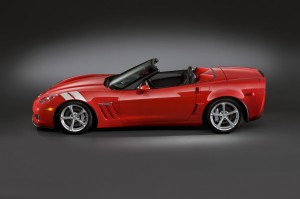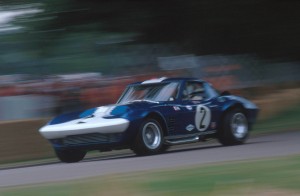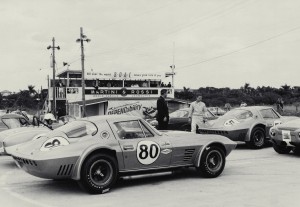
Wanna race?
GM’s reputation might be battered and bloodied these days, but there’s one car that is unbowed with its success taking on the world’s fastest and most expensive sports cars.
The Chevrolet Corvette for more than 50 years has proudly, and successfully, represented U.S. makers in the international sports car wars.
Dollar-for-performance-dollar, the Bowling Green, Kentucky, built two-seater represents the best performance value, bar none, in the world.
Today, at the 12 th annual C5/C6 Corvette Birthday Bash, held at the National Corvette Museum in Bowling Green, the new 2010 Corvette Grand Sport model made its return. The Grand Sport replaces the Corvette’s previous Z51 package and offers “even more handling performance,” with wider wheels and tires; revised damper, stabilizer bar and spring specifications, than the Z51, which was also a world-class competitor.
Cornering capabilities of +1.0 gravity, as well as a -0.2-second improvement in 0-60 acceleration compared to the standard LS3-powered models are claimed by Chevrolet. Based on my personal experience over the years doing instrumented testing on numerous Corvettes, I have no reason to doubt the impressive numbers. Corvettes deliver as promised.

The original 1963 Grand Sport where it belongs.
The new car is named after a Grand Sport that was originally created by Corvette chief engineer Zora Arkus-Duntov as a factory-built, lightweight racing model that would take on all domestic and overseas competitors in the hotly contested road races of the 1960s. Production of five prototypes ensued in 1963.
However, the project was shelved with GM’s agreement to stay out of manufacturer-backed motorsports during one of America’s recurrent attacks on the automobile. Unlike today, when such prototypes are routinely crushed for fear of liability claims, the five Grand Sport prototypes were raced throughout the 1960s by privateers who were personally picked by Duntov or his engineers.

Duntov commissioned five featherweight Grand Sport Corvettes to take on Carroll Shelby's Cobras.
GM management was no doubt shocked, shocked, that its cars were being successfully campaigned, especially since the winnings did not come back to GM.
Well, actually, GM garnered a larger, more valuable reward – the highly marketable, lucrative Corvette brand name that exists to this day. All five of the original cars survive, and are said to be among the most valuable in the collector’s market.
Unlike the original cars, the new Grand Sport models are spread across the line, including both coupe and convertible body styles, with either a six-speed manual or a six-speed paddle-shift automatic transmission. The LS3 6.2L V8 engine is rated at 430 horsepower (321 kW) and 424 pound feet of torque (575 Nm) with the standard exhaust system. An optional two-mode exhaust system elevates the power ratings to 436 horsepower (325 kW) and 428 pound feet (580 Nm).
Grand Sport coupe models equipped with the manual transmission are ready for the race track, with a dry-sump oiling system, differential cooler and a rear-mounted battery. May they be as successful as their namesakes.
